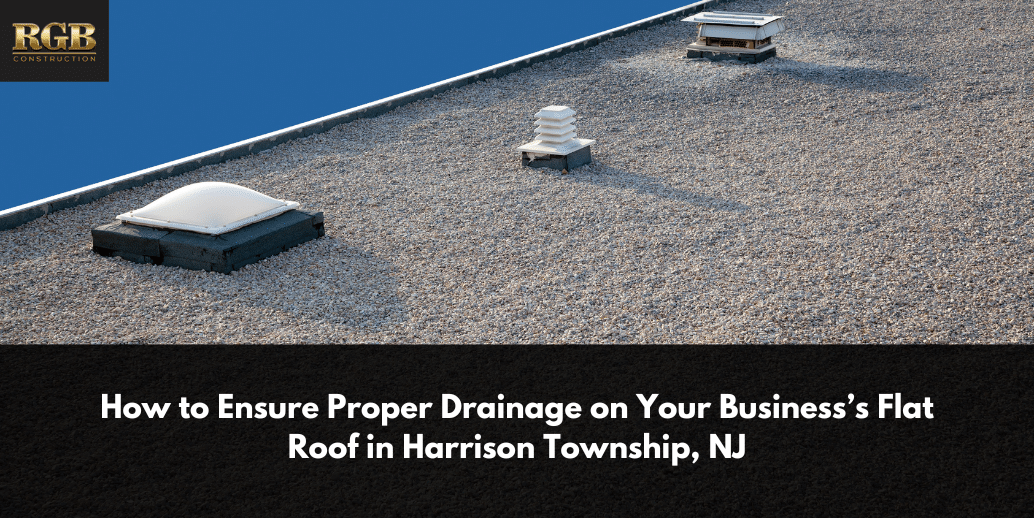Unlike sloped roofs that are slanted and capable of shedding water with ease, flat roofs are the exact opposite. How do you ensure proper drainage when the roof is flat, especially in places where rainfall happens frequently? Without adequate drainage, water can pool on the roof’s surface, leading to leaks, structural damage, and costly repairs. For businesses, maintaining the roof’s integrity is essential to protect the building, inventory, and operations. Here’s how you can ensure proper drainage on your business’s flat roof.
Key Takeaways
- Even flat roofs need a slight slope (about 1/4 inch per foot) for effective water drainage. Regularly inspect for and correct any pooling areas.
- Keep roof drains clear of debris and consider adding more drains in areas with heavy rainfall to prevent water accumulation.
- These components channel water off the roof and away from the building. Regularly check and clean them to ensure efficient drainage.
- A good gutter system prevents water damage. Ensure gutters are properly sloped, cleaned regularly, and consider using gutter guards to prevent clogs.
Know The Slope
Let’s clear a common misconception first. While flat roofs may appear level, they are designed with a slight slope to facilitate water drainage. The slope, typically around 1/4 inch per foot, directs water towards drains, scuppers, or gutters. Ensuring that your flat roof has the correct slope is the first step in preventing water accumulation. During routine inspections, check for areas where water tends to pool and address any irregularities that could indicate a problem with the roof’s slope.
Install and Maintain Roof Drains
Roof drains are essential components of a flat roof drainage system. These drains are strategically placed to collect water and channel it away from the roof surface. Regular maintenance of roof drains is critical; ensure they are free of debris, leaves, and other obstructions that could block the flow of water. In areas prone to heavy rain or snow, consider installing additional drains to handle increased water volume and prevent overloading the drainage system.
Use Scuppers and Downspouts
Scuppers are openings in the roof’s parapet wall that allow water to drain off the edge of the roof into downspouts. Downspouts then direct the water away from the building’s foundation. Scuppers and downspouts are particularly useful for handling large amounts of water during heavy rainfall. Ensure that scuppers are adequately sized and installed at the correct height to prevent water from accumulating on the roof. Regularly inspect and clean downspouts to prevent clogs and ensure efficient water flow.
Install a Proper Gutter System
Alongside scuppers and downspouts, you also want to ensure that the entire gutter system is functional. Gutters are an essential component to any roof, as they collect water from the roof’s edge and direct it into downspouts. For businesses, investing in a high-quality gutter system can prevent water damage to the roof and building structure. Ensure that gutters are properly sloped and securely attached to the building. Regular cleaning and maintenance are necessary to prevent clogs caused by leaves, dirt, and debris. In winter, consider installing gutter guards to reduce the risk of ice dams, which can obstruct water flow and cause damage.
Regular Inspections and Maintenance
Routine inspections and maintenance are key to ensuring proper drainage on your flat roof. Schedule regular inspections, especially after severe weather events, to check for signs of water pooling, blocked drains, or other issues. Address any problems promptly to prevent them from escalating into more significant damage. It’s also essential to inspect the roof membrane and flashing for signs of wear and tear, as these can compromise the roof’s waterproofing capabilities.
Work with Professional Roofing Contractors
Ensuring proper drainage on a flat roof requires expertise and experience. Working with professional roofing contractors, like those at RGB Construction, can help you design and maintain an effective drainage system. Professional contractors can assess your roof’s condition, recommend appropriate drainage solutions, and perform necessary repairs or upgrades. They can also provide regular maintenance services to keep your roof in optimal condition.
Contact a South Jersey Roofing Contractor Today to Learn More
Proper drainage is vital for maintaining the integrity and longevity of a flat roof, especially in regions like Harrison Township, NJ, where weather conditions can vary significantly. By understanding the importance of slope, maintaining roof drains, using scuppers and downspouts, installing a quality gutter system, conducting regular inspections, and considering green roofing options, you can protect your business’s roof from water damage. Working with professional roofing contractors ensures that your drainage system is correctly installed and maintained, providing peace of mind and safeguarding your investment.
If you’re concerned about the drainage on your business’s flat roof, contact RGB Construction today. Our team of experienced professionals is ready to help you design, install, and maintain a drainage system that keeps your roof in top condition. Let us help you protect your business and ensure the longevity of your roofing system.







